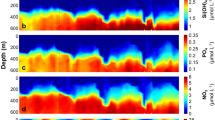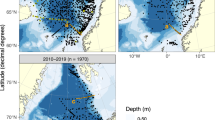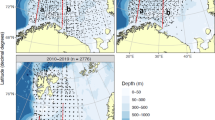Abstract
SEDIMENT traps are widely used to measure the vertical flux of particulate matter in the oceans. In the upper ocean, sediment traps have been used to determine the extent to which CO2 Axed by primary producers is exported as particulate organic carbon1–3. In addition, the observed decrease of particle flux with depth has been used to predict regeneration rates of organic matter and associated elements3. Over seasonal or annual timescales, the import of limiting nutrients into the upper ocean (new production) should be balanced by particle export4,5. Given the importance of accurately determining the sinking particle flux, it has been suggested that 234Th might be used to 'calibrate' shallow-trap fluxes6. Here I present a re-evaluation of existing 234Th data which indicates that trap-derived and model-derived 234Th particle fluxes can differ by a factor of ±3–10, suggesting that shallow traps may not provide an accurate measure of particle fluxes.
This is a preview of subscription content, access via your institution
Access options
Subscribe to this journal
Receive 51 print issues and online access
$199.00 per year
only $3.90 per issue
Buy this article
- Purchase on Springer Link
- Instant access to full article PDF
Prices may be subject to local taxes which are calculated during checkout
Similar content being viewed by others
References
Suess, E. Nature 288, 260–263 (1980).
Knauer, G. A. & Martin, J. H. Limnol. Oceanogr. 26, 181–186 (1981).
Martin, J. H., Knauer, G. A., Karl, D. M. & Broenkow, W. W. Deep-Sea Res. 34, 267–285 (1987).
Eppley, R. W. & Peterson, B. J. Nature 282, 677–680 (1979).
Eppley, R. W., Renger, E. H. & Betzer, P. R. Deep-Sea Res. 30, 311–323 (1983).
US Global Ocean Flux Study US GOFS Planning Rep. No. 10 (1989).
Chen, J. H., Edwards, L. & Wasserburg, G. J. Earth planet. Sci. Lett. 80, 241–251 (1986).
Coale, K. H. & Bruland, K. W. Limnol. Oceanogr. 30, 22–33 (1985).
Bhat, S. G., Lai, R. & Moore, W. S. Earth planet. Sci. Lett. 5, 483–491 (1969).
Santschi, P. H., Li, Y.-H. & Bell, J. Earth planet. Sci. Lett. 45, 201–213 (1979).
Coale, K. H. & Bruland, K. W. Limnol. Oceanogr. 32, 189–200 (1987).
Tsunogai, S., Taguchi, K. & Harada, K. J. oceanograph. Soc. Japan 42, 91–98 (1986).
Schmidt, S., Reyss, J. L., Nguyen, H. V. & Buat-Menard, P. Palaeogeogr. Palaeoclimatol. Palaeoecol. 89, 25–33 (1990).
Murray, J. W., Downs, J. N., Strom, S., Wei, C.-L. & Jannasch, H. W. Deep-Sea Res. 36, 1471–1489 (1989).
Buesseler, K. O., Bacon, M. P., Cochran, J. K. & Livingston, H. D. Deep-Sea Res. (in the press).
Knauer, G. A., Martin, J. H. & Bruland, K. W. Deep-Sea Res. A26, 97–108 (1979).
Bruland, K. W. & Coale, K. H. in Dynamic Process in the Chemistry of the Upper Ocean (eds Burton, J. D., Brewer, P. G. & Chesselet, R.) 159–172 (Plenum, New York, 1986).
Beals, D. M. & Bruland, K. W. Deep-Sea Res. (in the press).
Wei, C-L. & Murray, J. W. Limnol. Oceanogr. (in the press).
Wei, C-L. & Murray, J. W. Deep-Sea Res. (in the press).
Michaels, A. F., Silver, M. W., Gowing, M. M. & Knauer, G. A. Deep-Sea Res. 37, 1285–1296 (1990).
Coale, K. H. Limnol. Oceanogr. 35, 1376–1381 (1990).
Knauer, G. A., Karl, D. M., Martin, J. H. & Hunter, C. N. J. mar. Res. 42, 445–462 (1984).
Hargrave, B. T. & Burns, N. M. Limnol. Oceanogr. 24, 1124–1136 (1979).
Gardner, W. D. J. mar. Res. 38, 17–39 (1980).
Butman, C. A., Grant, W. D. & Stolzenbach, K. D. J. mar. Res. 44, 601–644 (1986).
Gust, G., Bowles, W., Giordano, S. & Huettel, M. J. mar. Res. (submitted).
White, J. Mar. Geophys. Res. 12, 145–152 (1990).
Gardner, W. D. Deep-Sea Res. 32, 349–361 (1985).
Fowler, S. W. & Knauer, G. A. Prog. Oceanogr. 16, 147–194 (1986).
Angel, M. V. in Productivity in the Ocean: Present and Past (eds Berger, W. H., Smetacek, V. S. & Wefer, G.) 155–175 (Wiley, New York, 1989).
Buat-Menard, P. et al. in Radionuclides: A Tool For Oceanography (eds Guary, J. C., Guegueniat, P. & Pentreath, R. J.) 121–130 (Elsevier, New York, 1988).
Author information
Authors and Affiliations
Rights and permissions
About this article
Cite this article
Buesseler, K. Do upper-ocean sediment traps provide an accurate record of particle flux?. Nature 353, 420–423 (1991). https://doi.org/10.1038/353420a0
Received:
Accepted:
Issue Date:
DOI: https://doi.org/10.1038/353420a0
This article is cited by
-
Assessing Deep-Pelagic Shrimp Biomass to 3000 m in The Atlantic Ocean and Ramifications of Upscaled Global Biomass
Scientific Reports (2019)
-
Biomarker-based Seawater Temperatures of Winter Sinking Particles and Core-top Sediment in the Ulleung Basin of the East Sea
Ocean Science Journal (2019)
-
δ13C and δ15N Values of Sediment-trap Particles in the Japan and Yamato Basins and Comparison with the Core-top Values in the East/Japan Sea
Ocean Science Journal (2018)
-
Dynamics of settling particulate matter during typhoon Muifa in Heini Bay, China
Chinese Journal of Oceanology and Limnology (2015)
-
Large mesopelagic fishes biomass and trophic efficiency in the open ocean
Nature Communications (2014)
Comments
By submitting a comment you agree to abide by our Terms and Community Guidelines. If you find something abusive or that does not comply with our terms or guidelines please flag it as inappropriate.



